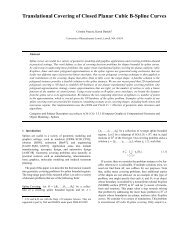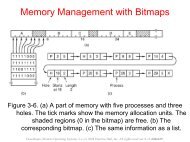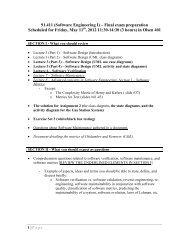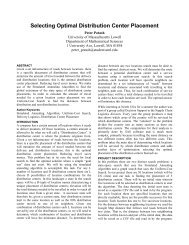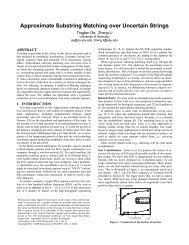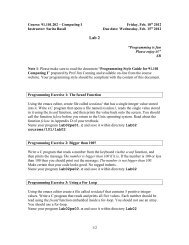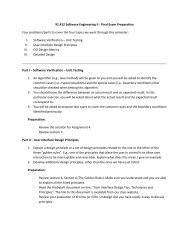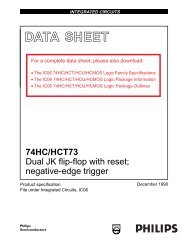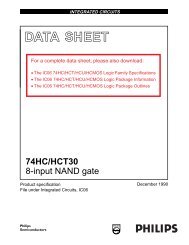CS1315: Introduction to Media Computation - Computer Science
CS1315: Introduction to Media Computation - Computer Science
CS1315: Introduction to Media Computation - Computer Science
Create successful ePaper yourself
Turn your PDF publications into a flip-book with our unique Google optimized e-Paper software.
6/23/2011<br />
<strong>Media</strong> Computing with Python<br />
Byung Kim and Fred Martin<br />
<strong>Computer</strong> <strong>Science</strong> Dept.<br />
UMass, Lowell<br />
{kim, fredm}@cs.uml.edu<br />
<strong>Media</strong> Computing with Python<br />
• <strong>Computer</strong> Programming Can Be Fun<br />
• Mark Guzdial, Georgia Tech<br />
• Problem space -- Digital media<br />
• Text, image, video, audio<br />
• <strong>Computer</strong> Programming<br />
• Process (steps) of manipulating data<br />
• Python language<br />
Table of Contents<br />
• <strong>Introduction</strong> <strong>to</strong> Python with JES (Jython Enviroment<br />
for Students)<br />
• Python functions<br />
• Colors and pictures<br />
• Change colors in pictures<br />
• Make a negative of a picture<br />
•Sounds<br />
• Reverse an audio file<br />
PYTHON<br />
•Python/Jython<br />
• Python is implemented in C<br />
• Jython is implemented in Java<br />
• JES (Jython Environment for Students)<br />
• Incorporates editing<br />
environment<br />
• Program pane<br />
• Command pane<br />
• Watcher but<strong>to</strong>n <strong>to</strong> view<br />
debugging<br />
•JES Download<br />
• Search for “JES Download”<br />
• http://coweb.cc.gatech.edu/<br />
mediaComp-teach/26<br />
1
6/23/2011<br />
<br />
<br />
<br />
<br />
<br />
<br />
Simple <strong>Computation</strong> in JES (+*/-%) Why is 3/2 = 1 ?<br />
Addition<br />
3 + 4<br />
Multiplication<br />
3 * 4<br />
Division<br />
3 / 4<br />
Subtraction<br />
3 – 4<br />
Negation<br />
-4<br />
Modulo (Remainder)<br />
10 % 2 and 11 % 2<br />
•Python is a typed language<br />
• Each value has a type associated with it<br />
• Tells the computer how <strong>to</strong> interpret the number<br />
• Built-in Types<br />
• int: 235, -2, 39402, etc.<br />
• float: 3.25, -52.95, etc.<br />
• string:<br />
>>> “Hello World!”<br />
>>> ‘Hi, there !’<br />
>>> “don’t do that”<br />
>>> ‘I said “S<strong>to</strong>p!”’<br />
>>> “Hey” + “ you!”<br />
• boolean: true or falst<br />
Variables<br />
• Name a value and re-use it<br />
• >>> x = 2*8<br />
• >>> x/2<br />
• >>> x<br />
• Whenever a variable name appears, it is substituted by its value<br />
• A variable name can be reused, redefined<br />
•Naming convention<br />
• MUST start with a letter followed by alphanumeric<br />
• aVar, cs100, …<br />
• CASE matters<br />
• ‘Print’ is not the same as ‘print’<br />
• ‘makePicture’ is not the same as ‘makepicture’, nor as<br />
‘Makepicture’<br />
• Multi-word name<br />
• First letter is capitalized<br />
• Convention, not absolute rule<br />
• Use sensible, meaningful name<br />
JES Functions<br />
• Functions pre-defined in JES for image and sound<br />
manipulation<br />
• pickAFile(): allows a user <strong>to</strong> select a file<br />
• makePicture(): creates and returns a picture object<br />
• show(): display a picture in the argument<br />
• makeSound(): creates and returns an audio object<br />
• play(): plays out a sound<br />
• A function returns a value<br />
• Like a quadratic f(x) = x 2 +5x-10, a sine(90), ..<br />
• A variable vs. a function<br />
• Variable can be reused with the same value (until re-assigned)<br />
• Function can be reused <strong>to</strong> return different values according <strong>to</strong><br />
arguments (some functions do not have arguments)<br />
2
6/23/2011<br />
Value, Variable, Function Return Value<br />
•Suppose we have a variable ‘file’<br />
>>> file = pickAFile()<br />
>>> print file<br />
C:\mediasources\barbara.jpg<br />
•Value of a variable in different forms<br />
>>> show(makePicture(file))<br />
>>> show(makePicture(r"C:\mediasources\barbara.jpg"))<br />
>>> show(makePicture(pickAFile()))<br />
LAB 1<br />
•In JES Command area,<br />
• Select any ‘.jpg’ file from C:\mediasources<br />
• Convert the selected file in<strong>to</strong> a picture file using<br />
‘makePicture()’<br />
• Display the picture using ‘show()’<br />
• Select any ‘.wav’ file from C:\mediasources<br />
• Convert the selected file in<strong>to</strong> a sound file using ‘makeSound()’<br />
• Replay the sound using ‘play()’<br />
NOTE: Put ‘r’ in front of Windows file path<br />
• r"C:\mediasources\barbara.jpg"<br />
Writing My Own Function<br />
• To create a function<br />
• Start with ‘def’<br />
• Name of the function<br />
• () with arguments within (), if any<br />
• End definition line with ‘:’<br />
• The body of the function is<br />
indented (by 2 spaces)<br />
• Called a block<br />
• Blue rectangle show<br />
commands (instructions) in<br />
the same block<br />
• White space matters!<br />
• End function with blank line, or<br />
by starting a new definition.<br />
Function pickAndShow()<br />
def pickAndShow():<br />
myFile = pickAFile()<br />
myPic= makePicture(myFile)<br />
show(myPic)<br />
• Note:<br />
• Variable names used in the command area are <strong>to</strong>tally different from<br />
those used in the program area<br />
• myFile, mySound<br />
• How <strong>to</strong> run the function that you created ?<br />
• Save in any name from File menu<br />
• Click ‘LOAD’ but<strong>to</strong>n<br />
• Type the function name in the command area<br />
3
6/23/2011<br />
Function <strong>to</strong> show the Same Picture<br />
def showThisPic():<br />
myFile = "xxxx.jpg"<br />
myPic = makePicture(myFile)<br />
show(myPic)<br />
• Note:<br />
• Put ‘r’ in front of Windows file path<br />
• r"C:\mediasources\barbara.jpg"<br />
• Called ‘hard-coded’<br />
• Program has <strong>to</strong> be changed <strong>to</strong> apply it <strong>to</strong> a different data<br />
Function with an Argument<br />
def pickAndShow():<br />
myFile = pickAFile()<br />
myPic = makePicture(myFile)<br />
play(myPic)<br />
def showThisPic():<br />
myFile = “xxxx.jpg”<br />
myPic = makePicture(myFile)<br />
show(myPic)<br />
def showMyFile(myFile):<br />
myPic = makePicture(myFile)<br />
show(myPic)<br />
def showMyPic(myPic):<br />
show(myPic)<br />
• Which function is better?<br />
• Cannot tell<br />
• Depending on what you want <strong>to</strong> achieve with functions<br />
• Are names correct ?<br />
• Spelling and CASE<br />
What Can Go Wrong ?<br />
• Indentation<br />
• Instructions in the same block have <strong>to</strong> be indented by the<br />
same amount<br />
• Variable Names<br />
• Variables in the command and the program areas are NOT<br />
related<br />
LAB 2<br />
•In JES Program area,<br />
• Write a function, pickAndPlay()<br />
• Select a file from a file browser<br />
• Convert the selected file <strong>to</strong> a sound file<br />
• Replay the sound file<br />
• Write a function, playSound(thisFile)<br />
•Convert ‘thisFile’ in<strong>to</strong> a sound file<br />
• Replay the sound file<br />
4
6/23/2011<br />
Colors<br />
Color Perception<br />
• Color is continuous<br />
• Visible light is in the<br />
wavelengths of 370<br />
and 730 nm<br />
(0.00000037 and<br />
0.00000073 meters)<br />
• We perceive colors<br />
differently<br />
• Human perception of light<br />
• With three color sensors<br />
• Peaks at 425 nm (blue), 550 nm (green), and 660 nm (red)<br />
• Our brain figures out color by how much of each<br />
sensor is responding<br />
• Dogs and other simpler animals have two sensors<br />
•They do see color. Just less color<br />
Luminance vs. Color<br />
• Luminance is a measure of light intensity<br />
• Luminance allows us <strong>to</strong> perceive borders of things, motion, depth<br />
• Luminance perception is color blind.<br />
• Brightness is our perception of luminance<br />
• brightness is not the amount of light, but our perception of the<br />
amount of light.<br />
• We see blue as “darker” than red, even if same amount of light.<br />
• Much of our luminance perception is based on comparison <strong>to</strong><br />
backgrounds, not raw values.<br />
• White’s illusion<br />
• Same gray luminance<br />
• Appears brighter in<br />
black stripe<br />
• Digitized as a bunch of dots<br />
(squares)<br />
• With enough dots, it looks<br />
continuous<br />
• Our eyes have limited resolution<br />
• Our background/depth acuity is<br />
particulary low<br />
• Each picture element is<br />
referred <strong>to</strong> as a pixel<br />
Digital Pictures<br />
• Different parts of the brain perceive color and luminance.<br />
5
6/23/2011<br />
Pixels<br />
• Pixels are picture elements<br />
• Each pixel object “knows” its color<br />
• e.g. given a pixel, a Python function can get the color out of it.<br />
• It also “knows” where it is in its picture<br />
• e.g. given a pixel and a picture, a Python function can find out where<br />
the pixel is located in the picture<br />
•A picture is a matrix of pixels<br />
• With rows of pixels as arrays<br />
• With two dimensions: Width and Height<br />
• We need a two-dimensional array: a matrix<br />
Referencing a Matrix<br />
We talk about positions in a<br />
matrix as (x,y), or (horizontal,<br />
vertical)<br />
Element (2,1) in the matrix at<br />
left is the value 12<br />
Element (1,3) is 6<br />
Color Encoding<br />
• Each pixel encodes color at that<br />
position in the picture<br />
• Most common for computers<br />
• RGB (Red, Green, Blue)<br />
• Each does appear as a separate dot on<br />
most devices, but our eye blends them.<br />
• In most computer-based models of RGB, a<br />
single byte (8 bits) is used for each<br />
Total RGB color is 24 bits<br />
Encoding RGB<br />
• Colors go from (0,0,0) <strong>to</strong><br />
(255,255,255)<br />
• If all components have the same<br />
values -> grayscale<br />
• (50,50,50) at (2,2)<br />
• (0,0,0) at (1,2) is black<br />
• (255,255,255) is white<br />
• Colors are represented in 24 bits<br />
• That is 16,777,216 (2 24 ) possible<br />
colors<br />
• Our eyes can discern millions of<br />
colors -> close<br />
• But, we don’t get 16 million colors<br />
from computer moni<strong>to</strong>rs<br />
6
6/23/2011<br />
What is a Picture in JES ?<br />
• A picture object in JES<br />
• Is an encoding that represents a picture<br />
• Knows its height and width<br />
• Knows how many pixels it has in both directions<br />
• Knows its file name<br />
• A picture is not a file<br />
• Only when you call makePicture(), it becomes a picture<br />
• But it knows which file it came from<br />
• Knows its window when opened by show() or repaint()<br />
Manipulating Pixels<br />
• getPixel(picture, x, y) <strong>to</strong> retrieve one pixel<br />
• getPixels(picture) <strong>to</strong> retrieve the entire pixels in an array<br />
>>> thisPixel=getPixel(myPic,1,1)<br />
>>> print thisPixel<br />
Pixel, color=color r=168 g=131 b=105<br />
>>> thisPixels=getPixels(myPic)<br />
>>> print thisPixels[0]<br />
Pixel, color=color r=168 g=131 b=105<br />
Square brackets:<br />
standard way <strong>to</strong> refer <strong>to</strong><br />
elements in an array<br />
What Can We Do with a Pixel<br />
Example<br />
• getRed, getGreen, and getBlue are functions that<br />
• return a color value (between 0 and 255) at a specified pixel<br />
• setRed, setGreen, and setBlue are functions that<br />
• set its color value at a specified pixel<br />
• We can also get, set, and make colors<br />
• getColor returns a Color object with three color values at a pixel<br />
• setColor sets the pixel <strong>to</strong> the specified color<br />
• makeColor returns a Color object with specified three color values<br />
• pickAColor lets you use a color chooser and returns the chosen<br />
color<br />
• We also have functions that can makeLighter and makeDarker<br />
an input color<br />
>>> thisPixel = getPixel(myPic,1,1)<br />
>>> print thisPixel<br />
Pixel, color=color r=168 g=131 b=105<br />
# get/set individual color values<br />
>>> print getRed(thisPixel)<br />
168<br />
>>> setRed(thisPixel,255)<br />
>>> print getRed(thisPixel)<br />
255<br />
>>> color=getColor(thisPixel)<br />
>>> print color<br />
color r=255 g=131 b=105<br />
>>> setColor(thisPixel,color)<br />
>>> newColor=makeColor(0,100,0)<br />
>>> print newColor<br />
color r=0 g=100 b=0<br />
>>> setColor(thisPixel,newColor)<br />
>>> print getColor(thisPixel)<br />
color r=0 g=100 b=0<br />
>>> print color<br />
color r=168 g=131 b=105<br />
>>> print makeDarker(color)<br />
color r=117 g=91 b=73<br />
>>> print color<br />
color r=117 g=91 b=73<br />
>>> newcolor=pickAColor()<br />
>>> print newcolor<br />
color r=255 g=51 b=51<br />
7
6/23/2011<br />
Change Colors Directly<br />
>>> file=“C:/mediasources/barbara.jpg"<br />
>>> pict=makePicture(file)<br />
>>> show(pict)<br />
>>> setColor(getPixel(pict,10,100),yellow)<br />
>>> setColor(getPixel(pict,11,100),yellow)<br />
>>> setColor(getPixel(pict,12,100),yellow)<br />
>>> setColor(getPixel(pict,13,100),yellow)<br />
>>> repaint(pict)<br />
LAB 3<br />
• In JES Command area,<br />
• Select a ‘.jpg’ file by pickAFile()<br />
• Convert the selected file <strong>to</strong> a picture file<br />
• Change any ten adjacent pixels in<strong>to</strong> red color<br />
• We did<br />
We Can Change Colors in Pixels<br />
>>> setColor(getPixel(pict,10,100),yellow)<br />
>>> setColor(getPixel(pict,11,100),yellow)<br />
>>> setColor(getPixel(pict,12,100),yellow)<br />
>>> setColor(getPixel(pict,13,100),yellow)<br />
• This is the same as<br />
>>> setColor(getPixel(pict,10,100),yellow)<br />
>>> setColor(getPixel(pict,10+1,100),yellow)<br />
>>> setColor(getPixel(pict,10+2,100),yellow)<br />
>>> setColor(getPixel(pict,10+3,100),yellow)<br />
• We have<br />
Any Way <strong>to</strong> Au<strong>to</strong>mate This ?<br />
>>> setColor(getPixel(pict,10,100),yellow)<br />
>>> setColor(getPixel(pict,10+1,100),yellow)<br />
>>> setColor(getPixel(pict,10+2,100),yellow)<br />
>>> setColor(getPixel(pict,10+3,100),yellow)<br />
• Problem solving – like a cooking recipe, a manual, …<br />
• Get an overall idea of how <strong>to</strong> approach the problem => PROCESS<br />
• Specify the steps <strong>to</strong> go through <strong>to</strong> solve the problem<br />
• Use the syntax in the given programming language<br />
• “for var in range(0, 4):”<br />
>>> for i in range(4):<br />
… setColor(getPixel(pict,10+i,100),yellow)<br />
8
6/23/2011<br />
Want <strong>to</strong> Reduce Red Colors in Every Pixel<br />
• Process (Recipe)<br />
• Given a picture<br />
• For each pixel,<br />
• Get what red value it has<br />
• Reduce its value by x %<br />
• Replace (set) the red value by the reduced one<br />
• Now, syntax part !<br />
• How <strong>to</strong> tell computer <strong>to</strong> get every pixel ?<br />
• Remember getPixels() ?<br />
This is an<br />
itera<strong>to</strong>r!<br />
def decreaseRed():<br />
picture = makePicture(r”C:\mediasources\beach.jpg”)<br />
for p in getPixels(picture):<br />
value=getRed(p)<br />
setRed(p,value*0.5)<br />
For Loop<br />
def decreaseRed():<br />
picture = makePicture(r”C:\mediasources\beach.jpg”)<br />
for p in getPixels(picture):<br />
value=getRed(p)<br />
setRed(p,value*0.5)<br />
• for is the name of the command<br />
• An index variable (p) is used <strong>to</strong> represent the different values in<br />
the loop<br />
• Otherwise, how does the computer tell which one is being<br />
processed ?<br />
• The word in<br />
• A function that generates a sequence<br />
• The index variable will be the name for each value in the<br />
sequence, each time through the loop<br />
• A colon (“:”)<br />
• And, another block<br />
How is for Loop executed ? Walk-through 0<br />
• The index variable is set <strong>to</strong> first item in the sequence<br />
• The block is executed<br />
• The variable is often used inside the block<br />
• After the block completes its execution, it returns <strong>to</strong> the for statement<br />
• AND the index variable gets set <strong>to</strong> the next item in the sequence<br />
• Repeat until the sequence is exhausted.<br />
• In our example,<br />
• getPixels() returns a sequence of pixels<br />
• Each pixel in the index variable p knows its color and its original picture<br />
• Change the pixel, you change the picture<br />
def decreaseRed():<br />
picture = makePicture(r"C:\mediasources\beach.jpg")<br />
for p in getPixels(picture):<br />
value=getRed(p)<br />
setRed(p,value*0.5)<br />
Pick a picture and call it ‘picture’<br />
picture<br />
9
6/23/2011<br />
Walk-through 1<br />
def decreaseRed():<br />
picture = makePicture(r”C:\mediasources\beach.jpg”)<br />
for p in getPixels(picture):<br />
value=getRed(p)<br />
setRed(p,value*0.5)<br />
We get all the pixels from the picture,<br />
then make p be the name of each one<br />
one at a time<br />
picture<br />
getPixels()<br />
Pixel,<br />
color<br />
r=168<br />
g=131<br />
b=105<br />
Pixel,<br />
color<br />
r=160<br />
g=131<br />
b=105<br />
Pixel,<br />
color<br />
r=168<br />
g=132<br />
b=106<br />
…<br />
Walk-through 2<br />
def decreaseRed():<br />
picture = makePicture(r”C:\mediasources\beach.jpg”)<br />
for p in getPixels(picture):<br />
value=getRed(p)<br />
setRed(p,value*0.5) We get the red value of pixel p and<br />
name it value<br />
picture<br />
getPixels()<br />
Pixel,<br />
color<br />
r=168<br />
g=131<br />
b=105<br />
Pixel,<br />
color<br />
r=160<br />
g=131<br />
b=105<br />
Pixel,<br />
color<br />
r=168<br />
g=132<br />
b=106<br />
…<br />
p<br />
p<br />
value = 168<br />
Walk-through 3<br />
Walk-through 4<br />
def decreaseRed():<br />
picture = makePicture(r”C:\mediasources\beach.jpg”)<br />
for p in getPixels(picture):<br />
value=getRed(p)<br />
setRed(p,value*0.5)<br />
Set the red value of pixel p<br />
<strong>to</strong> 0.5 (50%) of value<br />
def decreaseRed():<br />
picture = makePicture(r”C:\mediasources\beach.jpg”)<br />
for p in getPixels(picture):<br />
value=getRed(p)<br />
setRed(p,value*0.5)<br />
Then move on<strong>to</strong> the next<br />
pixel<br />
picture<br />
picture<br />
getPixels()<br />
Pixel,<br />
color<br />
r=84<br />
g=131<br />
b=105<br />
Pixel,<br />
color<br />
r=160<br />
g=131<br />
b=105<br />
Pixel,<br />
color<br />
r=168<br />
g=132<br />
b=106<br />
…<br />
getPixels()<br />
Pixel,<br />
color<br />
r=84<br />
g=131<br />
b=105<br />
Pixel,<br />
color<br />
r=160<br />
g=131<br />
b=105<br />
Pixel,<br />
color<br />
r=168<br />
g=132<br />
b=106<br />
…<br />
p<br />
value = 168<br />
p<br />
value = 168<br />
10
6/23/2011<br />
Walk-through 5<br />
def decreaseRed():<br />
picture = makePicture(r”C:\mediasources\beach.jpg”)<br />
for p in getPixels(picture):<br />
value=getRed(p)<br />
setRed(p,value*0.5) Get its red value <strong>to</strong> value<br />
Walk-through 6<br />
def decreaseRed():<br />
picture = makePicture(r”C:\mediasources\beach.jpg”)<br />
for p in getPixels(picture):<br />
value=getRed(p)<br />
setRed(p,value*0.5)<br />
Update red value <strong>to</strong> a half<br />
of value<br />
picture<br />
picture<br />
getPixels()<br />
Pixel,<br />
color<br />
r=84<br />
g=131<br />
b=105<br />
Pixel,<br />
color<br />
r=160<br />
g=131<br />
b=105<br />
Pixel,<br />
color<br />
r=168<br />
g=132<br />
b=106<br />
…<br />
getPixels()<br />
Pixel,<br />
color<br />
r=84<br />
g=131<br />
b=105<br />
Pixel,<br />
color<br />
r=80<br />
g=131<br />
b=105<br />
Pixel,<br />
color<br />
r=168<br />
g=132<br />
b=106<br />
…<br />
p value = 160<br />
p value = 160<br />
Eventually<br />
• Repeat for all pixels<br />
• Go from this <strong>to</strong> this<br />
Reduce reds in All Pixels with For<br />
• for p in getPixels(picture)<br />
Initialize<br />
variables<br />
for p in<br />
getPixels(picture):<br />
More<br />
elements<br />
true<br />
Do statements<br />
false<br />
Change loop<br />
variables<br />
Statements<br />
11
6/23/2011<br />
Tracing/Stepping/Walking Through<br />
•What we just did is called “stepping” or “walking through”<br />
the program<br />
• You consider each step of the program, in the order that the<br />
computer would execute it<br />
• You consider what would specifically happen there<br />
• You write down what values each variable (name) has at each<br />
point.<br />
•It’s one of the most important debugging skills you can<br />
have.<br />
•And everyone has <strong>to</strong> do a lot of debugging, especially at first.<br />
LAB 4<br />
•In JES Program area,<br />
• Write a function, increaseRed(picFile)<br />
• Increases a red value in every pixel in the picture file,<br />
picFile, by 30%<br />
•And run the new function increaseRed(picFile) in the<br />
Command area<br />
Make decreaseRed() More General ?<br />
def decreaseRed():<br />
picture = makePicture(r"C:\mediasources\beach.jpg")<br />
for p in getPixels(picture):<br />
value=getRed(p)<br />
setRed(p,value*0.5)<br />
•decreaseRed() works only for beach picture<br />
•How <strong>to</strong> generalize it ?<br />
• Decrease red color can be applied <strong>to</strong> any picture<br />
• Remove hard-coding<br />
• Have the picture be specified<br />
def decreaseRed(picture):<br />
for p in getPixels(picture):<br />
value=getRed(p)<br />
setRed(p,value*0.5)<br />
•How can we be sure ?<br />
• Sure, the picture looks<br />
different<br />
• But, did we indeed<br />
decrease the amount of<br />
red ?<br />
• And by the exact amount<br />
we want ?<br />
• We can check a few<br />
pixels as on the right<br />
Did It Really Work ?<br />
>>> file = pickAFile()<br />
>>> print file<br />
C:\mediasources\beach.jpg<br />
>>> pict = makePicture(file)<br />
# check one pixel values<br />
>>> pixel = getPixel(pict,1,1)<br />
>>> print pixel<br />
Pixel, color=color r=168 g=131 b=105<br />
>>> decreaseRed(pict)<br />
>>> print pixel<br />
Pixel, color=color r=168 g=131 b=105<br />
# check updated values of the same pixel<br />
>>> newPixel = getPixel(pict,1,1)<br />
>>> print newPixel<br />
Pixel, color=color r=84 g=131 b=105<br />
>>> print 168 * 0.5<br />
84.0<br />
12
6/23/2011<br />
Read it as a Recipe<br />
def decreaseRed(picture):<br />
for p in getPixels(picture):<br />
value=getRed(p)<br />
setRed(p,value*0.5)<br />
• Recipe: To decrease the red<br />
• Ingredients: One picture, name it picture<br />
• Step 1: Get all the pixels of picture. For each pixel p in the pixels…<br />
• Step 2: Get the value of the red of pixel p, and set it <strong>to</strong> 50% of its<br />
original value<br />
What happened here?!?<br />
Increasing Red<br />
def increaseRed(picture):<br />
for p in getPixels(picture):<br />
value=getRed(p)<br />
setRed(p,value*1.2)<br />
Remember that the limit for redness is 255.<br />
If you go beyond 255, all kinds of weird things can<br />
happen<br />
How does increaseRed differ from decreaseRed?<br />
• Well, it does increase rather than decrease red, but other<br />
than that…<br />
• It takes the same input<br />
• It can also work for any picture<br />
• It’s a specification of a process that will work for any picture<br />
• There’s nothing specific <strong>to</strong> any picture here.<br />
Clearing Blue<br />
def clearBlue(picture):<br />
for p in getPixels(picture):<br />
setBlue(p,0)<br />
Again, this will work for any picture.<br />
Try stepping through this one yourself!<br />
13
6/23/2011<br />
• How do we turn this beach<br />
scene in<strong>to</strong> a sunset?<br />
• What happens at sunset?<br />
• At first, try increasing the red<br />
• but that made things like red<br />
specks in the sand REALLY<br />
prominent.<br />
• That can’t be how it really<br />
works<br />
• New Theory:<br />
• As the sun sets, less blue<br />
and green is visible<br />
• This makes things look<br />
more red.<br />
Can we combine these?<br />
A Sunset-generation Function<br />
def makeSunset(picture):<br />
for p in getPixels(picture):<br />
value=getBlue(p)<br />
setBlue(p,value*0.7)<br />
value=getGreen(p)<br />
setGreen(p,value*0.7)<br />
• What is a negative ?<br />
• R,G,B go from 0 <strong>to</strong> 255<br />
Creating a Negative<br />
• Let’s say Red is 10. That’s very light red.<br />
• What’s the opposite? LOTS of Red!<br />
• The negative of that would be 245: 255-10<br />
• Process<br />
• For each pixel,<br />
• negate each color component in creating a new color<br />
• Then, we negate the whole picture.<br />
Recipe for Creating a Negative<br />
def negative(picture):<br />
for px in getPixels(picture):<br />
red=getRed(px)<br />
green=getGreen(px)<br />
blue=getBlue(px)<br />
negColor=makeColor( 255-red, 255-green, 255-blue)<br />
setColor(px,negColor)<br />
14
6/23/2011<br />
Original, negative, double negative<br />
Converting <strong>to</strong> Grayscale<br />
• We know that if red=green=blue, we get gray<br />
• But what value do we set all three <strong>to</strong>?<br />
• What we need is a value representing the darkness of the<br />
color, the luminance<br />
• There are lots of ways of getting it, but one way that works<br />
reasonably well is dirt simple—simply take the average:<br />
(This gives us a quick way <strong>to</strong> test our function:<br />
Call it twice and see if the result is equivalent<br />
<strong>to</strong> the original)<br />
Converting <strong>to</strong> grayscale<br />
def grayScale(picture):<br />
for p in getPixels(picture):<br />
intensity = (getRed(p)+getGreen(p)+getBlue(p))/3<br />
setColor(p,makeColor(intensity,intensity,intensity))<br />
LAB 5<br />
•In JES Program area,<br />
• Write a function <strong>to</strong> create a negative or a grayscale of a picture<br />
•And run the new function in the Command area<br />
15
6/23/2011<br />
How sound works:<br />
Acoustics, the physics of sound<br />
• Sounds are waves of air<br />
pressure<br />
• Sound comes in cycles<br />
• The frequency of a wave is<br />
the number of cycles per<br />
second (cps), or Hertz<br />
• (Complex sounds have<br />
more than one frequency<br />
in them.)<br />
• The amplitude is the<br />
maximum height of the wave<br />
Volume and pitch:<br />
• Our perception of volume is related (logarithmically) <strong>to</strong><br />
changes in amplitude<br />
• If the amplitude doubles, it’s about a 3 decibel (dB)<br />
change<br />
• Our perception of pitch is related (logarithmically) <strong>to</strong><br />
changes in frequency<br />
• Higher frequencies are perceived as higher pitches<br />
• We can hear between 5 Hz and 20,000 Hz (20 kHz)<br />
• A above middle C is 440 Hz<br />
Digitizing Sound: How do we get that in<strong>to</strong><br />
numbers?<br />
• Remember in calculus,<br />
estimating the curve by<br />
creating rectangles?<br />
• We can do the same <strong>to</strong><br />
estimate the sound curve<br />
• Analog-<strong>to</strong>-digital conversion<br />
(ADC) will give us the<br />
amplitude at an instant as a<br />
number: a sample<br />
• How many samples do we<br />
need?<br />
Nyquist Theorem<br />
• We need twice as many samples as the maximum<br />
frequency in order <strong>to</strong> represent (and recreate, later) the<br />
original sound.<br />
• The number of samples recorded per second is the<br />
sampling rate<br />
• If we capture 8000 samples per second, the highest frequency we<br />
can capture is 4000 Hz<br />
• That’s how phones work<br />
• If we capture more than 44,000 samples per second, we capture<br />
everything that we can hear (max 22,000 Hz)<br />
• CD quality is 44,100 samples per second<br />
16
6/23/2011<br />
Digitizing Sound<br />
• Each sample is s<strong>to</strong>red as a number (two bytes)<br />
• What’s the range of available combinations?<br />
• 16 bits, 2 16 = 65,536<br />
• But we want both positive and negative values<br />
• What if we use one bit <strong>to</strong> indicate positive (0) or negative (1)?<br />
• That leaves us with 15 bits<br />
• 15 bits, 2 15 = 32,768<br />
• One of those combinations will stand for zero<br />
• We’ll use a “positive” one, so that’s one less pattern for<br />
positives<br />
• Each sample can be between -32,768 and 32,767<br />
Sounds as arrays<br />
• Samples are just s<strong>to</strong>red one right after the other in the<br />
computer’s memory<br />
• That’s called an array<br />
It’s an especially efficient (quickly accessed) memory<br />
structure<br />
Working with sounds<br />
• We’ll use pickAFile and makeSound as we have before.<br />
• But now we want .wav files<br />
• We’ll use getSamples <strong>to</strong> get all the sample objects out of a<br />
sound<br />
• We can also get the value at any index with<br />
getSampleValueAt(sound, index)<br />
• A sample object remembers its sound, so if you change the<br />
sample object, the sound gets changed by<br />
• setSample(sample,value)<br />
• Can save sounds with writeSoundTo(sound,”file.wav”)<br />
Example<br />
>>> soundfile=pickAFile()<br />
>>> sound=makeSound(soundfile)<br />
>>> sample=getSampleObjectAt(sound,1)<br />
>>> print sample<br />
Sample at 1 value at 59<br />
>>> print sound<br />
Sound of length 387573<br />
>>> print getSound(sample)<br />
Sound of length 387573<br />
>>> print getSample(sample)<br />
59<br />
>>> setSample(sample,29)<br />
>>> print getSample(sample)<br />
29<br />
17
6/23/2011<br />
Recipe <strong>to</strong> Increase the Volume<br />
Loop Executions<br />
def increaseVolume(sound):<br />
for sample in getSamples(sound):<br />
value = getSample(sample)<br />
setSample(sample,value * 2)<br />
• getSamples(sound)<br />
returns a sequence of all<br />
the sample objects in the<br />
sound.<br />
• The for loop makes<br />
sample be the first<br />
sample as the block is<br />
started.<br />
Decreasing the volume<br />
Recognize some similarities?<br />
def decreaseVolume(sound):<br />
for sample in getSamples(sound):<br />
value = getSample(sample)<br />
setSample(sample,value * 0.5)<br />
def increaseVolume(sound):<br />
for sample in getSamples(sound):<br />
value = getSample(sample)<br />
setSample(sample,value * 2)<br />
def increaseRed(picture):<br />
for p in getPixels(picture):<br />
value=getRed(p)<br />
setRed(p,value*1.2)<br />
This works just like increaseVolume,<br />
but we’re lowering each sample by<br />
50% instead of doubling it.<br />
def decreaseVolume(sound):<br />
for sample in getSamples(sound):<br />
value = getSample(sample)<br />
setSample(sample,value * 0.5)<br />
def decreaseRed(picture):<br />
for p in getPixels(picture):<br />
value=getRed(p)<br />
setRed(p,value*0.5)<br />
18
6/23/2011<br />
Increasing volume by index<br />
def increaseVolumeByRange(sound):<br />
for index in range(1, getLength(sound)+1):<br />
value = getSampleValueAt(sound, index)<br />
setSampleValueAt(sound, index, value * 2)<br />
This really is the same as:<br />
def increaseVolume(sound):<br />
for sample in getSamples(sound):<br />
value = getSample(sample)<br />
setSample(sample,value * 2)<br />
Recipe <strong>to</strong> play a sound backwards<br />
def backwards(filename):<br />
source = makeSound(filename)<br />
target = makeSound(filename)<br />
sourceIndex = getLength(source)<br />
for targetIndex in range(1, getLength(target)+1):<br />
sourceValue = getSampleValueAt(source,sourceIndex)<br />
setSampleValueAt(target,targetIndex,sourceValue)<br />
sourceIndex = sourceIndex - 1<br />
return target<br />
Note use of return for returning<br />
the processed sound<br />
How does this work?<br />
• We make two copies of the sound<br />
• The sourceIndex starts at the end, and the targetIndex goes<br />
from 1 <strong>to</strong> the end.<br />
• Each time through the loop, we copy the sample value from<br />
the sourceIndex <strong>to</strong> the targetIndex<br />
Note that the targetIndex is increasing whereas the sourceIndex<br />
is subtracting 1 each time through the loop<br />
Starting out (3 samples here)<br />
def backwards(filename):<br />
source = makeSound(filename)<br />
target = makeSound(filename)<br />
sourceIndex = getLength(source)<br />
for targetIndex in range(1,getLength(target)+1):<br />
sourceValue = getSampleValueAt(source,sourceIndex)<br />
setSampleValueAt(target,targetIndex,sourceValue)<br />
sourceIndex = sourceIndex - 1<br />
return target<br />
12 25 13 12 25 13<br />
source<br />
target<br />
19
6/23/2011<br />
Ready for the copy<br />
def backwards(filename):<br />
source = makeSound(filename)<br />
target = makeSound(filename)<br />
sourceIndex = getLength(source)<br />
for targetIndex in range(1,getLength(target)+1):<br />
sourceValue = getSampleValueAt(source,sourceIndex)<br />
setSampleValueAt(target,targetIndex,sourceValue)<br />
sourceIndex = sourceIndex - 1<br />
Do the copy<br />
def backwards(filename):<br />
source = makeSound(filename)<br />
target = makeSound(filename)<br />
sourceIndex = getLength(source)<br />
for targetIndex in range(1,getLength(target)+1):<br />
sourceValue = getSampleValueAt(source,sourceIndex)<br />
setSampleValueAt(target,targetIndex,sourceValue)<br />
sourceIndex = sourceIndex - 1<br />
return target<br />
return target<br />
sourceIndex<br />
targetIndex<br />
sourceIndex<br />
targetIndex<br />
12 25 13 12 25 13<br />
source<br />
target<br />
12 25 13 13 25 13<br />
source<br />
target<br />
Ready for the Next One ?<br />
def backwards(filename):<br />
source = makeSound(filename)<br />
target = makeSound(filename)<br />
sourceIndex = getLength(source)<br />
for targetIndex in range(1,getLength(target)+1):<br />
sourceValue = getSampleValueAt(source,sourceIndex)<br />
setSampleValueAt(target,targetIndex,sourceValue)<br />
sourceIndex = sourceIndex - 1<br />
return target<br />
sourceIndex<br />
targetIndex<br />
12 25 13 13 25 13<br />
source<br />
target<br />
Add Sounds with Delay<br />
• Add in sound2 after 1000 samples<br />
• Add in sound3 after 2000 samples<br />
def makeChord(sound1,sound2,sound3):<br />
for index in range(1,getLength(sound1)):<br />
s1Sample = getSampleValueAt(sound1,index)<br />
if index > 1000:<br />
s2Sample=getSampleValueAt(sound2,index-1000)<br />
setSampleValueAt(sound1,index,s1Sample+s2Sample)<br />
if index > 2000:<br />
s3Sample = getSampleValueAt(sound3,index-2000)<br />
setSampleValueAt(sound1,index,s1Sample + s2Sample<br />
+ s3Sample)<br />
20
6/23/2011<br />
Sound 1<br />
Sound 2<br />
Sound 3<br />
Add Sounds with Delay<br />
1000<br />
2000<br />
LAB 6<br />
•In JES Program area,<br />
• Write a function, createEcho (soundFile)<br />
• To add an echo of soundFile<br />
Sound 1<br />
21




